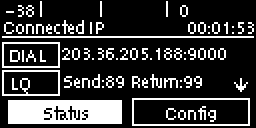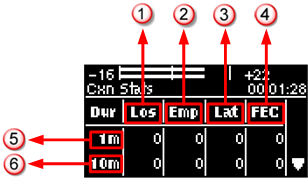
The number of active audio streams and connections is displayed on the Home screen via Cxns. In the following image the program has two connections configured and both are active, expressed as 2/2. If only one was active the bracketed number would display 1/2.

To view more detailed connection information:
1.Press the HOME  button to return to the Home screen.
button to return to the Home screen.
2.Use the navigation buttons to select Cxns and press the  button.
button.
The Connected IP screen displays all connections. The IP address dialed and the LQ (link quality) is displayed on the screen and you can use the down  navigation button to view the algorithm being used, the connection bit rate, total bytes used and the jitter buffer latency over IP network connections.
navigation button to view the algorithm being used, the connection bit rate, total bytes used and the jitter buffer latency over IP network connections.

Link Quality (LQ) Readings
Send and return LQ numbers can also help to determine if a problem is occurring at either end of a connection. For example, on an IP connection the Return reading represents the audio being downloaded from the network locally (i.e. audio data is being sent by the remote codec). Conversely, the Send link quality reading represents the audio data being sent by the local codec (i.e. being downloaded by the remote codec). To ensure a stable connection, try to maintain a reliable reading of 80 or higher for both the Send and Return LQ reading.
|
Important Note: •The Return link quality reading is the same as the Local (L) setting displayed on a G3 codec. •The Send link quality reading is the same as the Remote (R) setting displayed on a G3 codec. |
Viewing Connection Statistics
Navigate to Status in the Connected IP screen and press the  button to display the Cxn Stats (connection statistics) screen. This displays the performance of the codec in sending IP audio packets across the network. Analysis is historic and assessed over 60 seconds and 10 minutes of connection time.
button to display the Cxn Stats (connection statistics) screen. This displays the performance of the codec in sending IP audio packets across the network. Analysis is historic and assessed over 60 seconds and 10 minutes of connection time.

|
Feature |
Description |
1 |
Lost Packets |
Packets sent that failed to arrive |
2 |
Empty (Jitter Buffer) |
Indicates how often the jitter buffer ‘reservoir’ empties causing loss of audio |
3 |
Late Packets |
The number of packets that arrive late, i.e. after audio play out |
4 |
FEC Packets |
Indicates the number of forward error correction (FEC) packets that have been replaced if it is enabled in the codec |
5 |
1 minute |
Statistics listed for the last minute of network activity |
6 |
10 minutes |
Statistics for the last 10 minutes of network activity |
|
Important Note: If the jitter buffer, FEC or the connection bit rate is changed, we recommend assessing a minute of recent connection performance in preference to 10 minutes of historical connection performance. 10 minutes of data will include connection settings which may no longer be relevant. ‘Packet arrival history’ is cleared when you hang up a connection. |
Following is an analysis of possible causes and solutions for the packet analysis statistics displayed on the screen.
Packet Analysis |
Displays |
Possible Causes |
Possible Solutions |
Loss |
Packets failed to arrive. |
•LAN/WAN congestion •Unreliable ISPs •Unreliable networks •Unreliable IP hardware |
•Renegotiate connection bit rate downwards •If link quality good add or increase FEC as required •Assess ISP’s QoS if very bad performance |
Empty |
Indicates how often the jitter buffer ‘reservoir’ empties causing loss of audio. |
•High number of packets being lost or arriving late •Signal drop-outs using cell-phone networks •Renegotiation causes the jitter buffer reservoir to empty |
•Once could be an anomaly – assess lost & late packets •If many lost packets network is unreliable – renegotiate bit rate and /or FEC down •If many late packets increase jitter buffer |
Late |
The number of packets that arrive late and after audio play out. |
•Network congestion •Jitter Buffer depth is too low |
•Auto-jitter buffer will adjust automatically •For manual jitter buffer settings increase jitter buffer depth 50-100 ms & reassess (if only a few packets arrive late over time, audio repairs will be automatic and may not require buffer changes). |
FECd |
Indicates the number of FEC repaired packets if FEC active. |
•Packets have been lost or corrupted over the network |
•Assess audio quality & the number of FEC repairs – if many packets are being ‘lost’ perhaps reduce FEC &/or renegotiate bit rate down. |

